Religion and Morality – Part 1: Divorce Rates
It is generally believed that religion makes people morally good, or that religion is a significant factor in making religious people morally better than non-religious people. Christians generally believe that the Christian religion makes Christians morally better than non-religious people. But there is a good deal of evidence that casts doubt on these widely held beliefs.
One piece of evidence is this: DIVORCE RATES. Divorce is an important moral issue, at least from a Christian point of view.
There are a few reasons for thinking divorce is a moral issue. First, marriage, at least for Christians, involves promises or vows. Keeping promises or vows or commitments is a part of being a morally good person. Second, one of the Ten Commandments prohibits people from committing adultery (at least that is how most Christians understand the Ten Commandments), so Christians and Jews view adultery as a serious moral evil. Cheating or sexual infidelity is a major cause or reason for divorce.
Third, because cheating or infidelity usually involves deception and lying, divorces that arise from cheating or infidelity also arise from deception and lying, which are clearly moral issues. Fourth, Jesus took a strong stand against divorce, teaching that adultery was the only legitimate reason for divorcing a spouse. So, Christians view divorce as a failure to follow the teachings of Jesus, except in the case where one of the spouses was sexually unfaithful.
Finally, if a person is generous, kind, and fair, then that person is more likely to have a strong and long-lasting marriage than a person who is selfish, cruel, and unfair. In other words, a person of good moral character is more likely to have a strong and long-lasting marriage than a person who has poor moral character, other things being equal. So, it is reasonable to expect that a population consisting mostly of people of good moral character would have a lower divorce rate than a population consisting mostly of people of poor moral character.
If religion helps religious people to be morally better than nonreligious people, and if Christianity helps Christians to be morally better than nonreligious people, then we would expect divorce rates to be lower for religious people/Christians than for non-religious people, lower in states where religion/Christianity is more prevalent than in states where religion is less prevalent, and lower in times when religion/Christianity is more prevalent than in times when religion/Christianity is less prevalent. But this is NOT what the facts show.
COMPARISON OVER TIME: RELIGION HAS BEEN DECREASING IN THE USA FOR DECADES WHILE DIVORCE HAS ALSO BEEN DECREASING
The rate of divorce in the USA has been declining since 1980, but so has religion and Christianity! Here is a graph showing the decline in the divorce rate between 1980 and 2020:
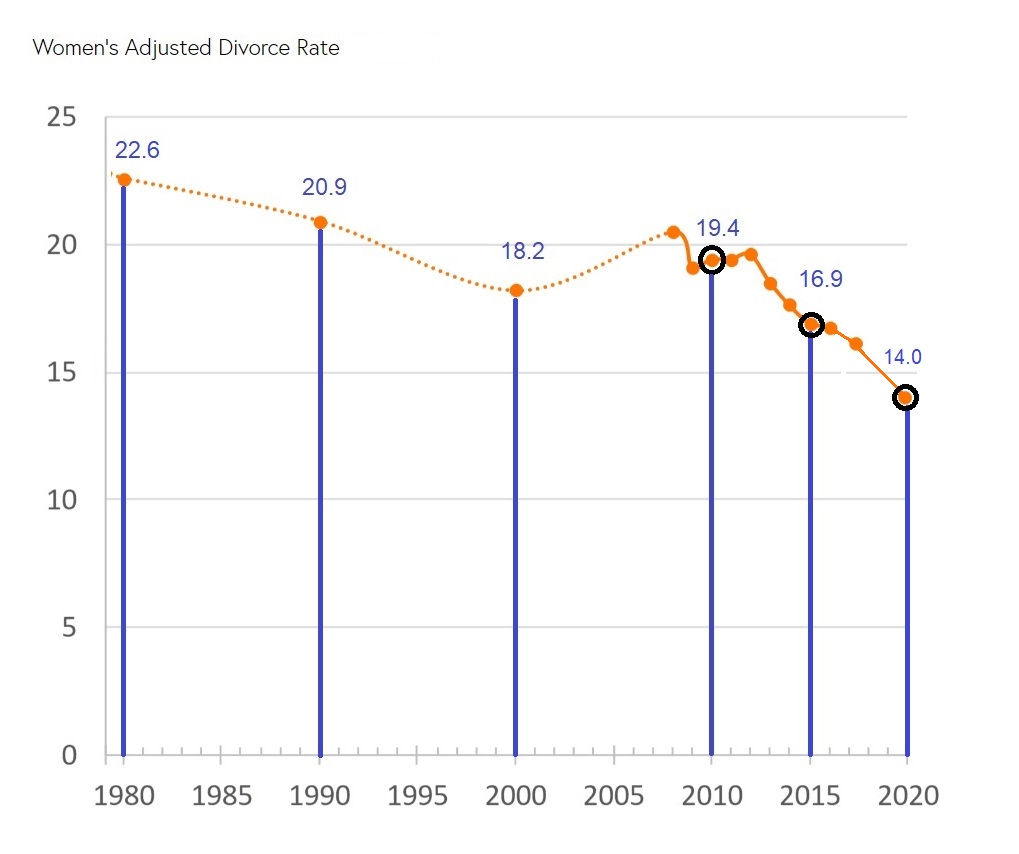
This graph is based on data gathered by The National Center for Marriage and Family Research at Bowling Green State University: https://www.bgsu.edu/ncfmr/resources/data/resources-by-topic/marriage-divorce-rates.html
While the divorce rate was declining in the USA, so was religion and Christianity. There has been a significant increase in the portion of the population that are NONES–people who do not identify with any religion–over the past few decades:
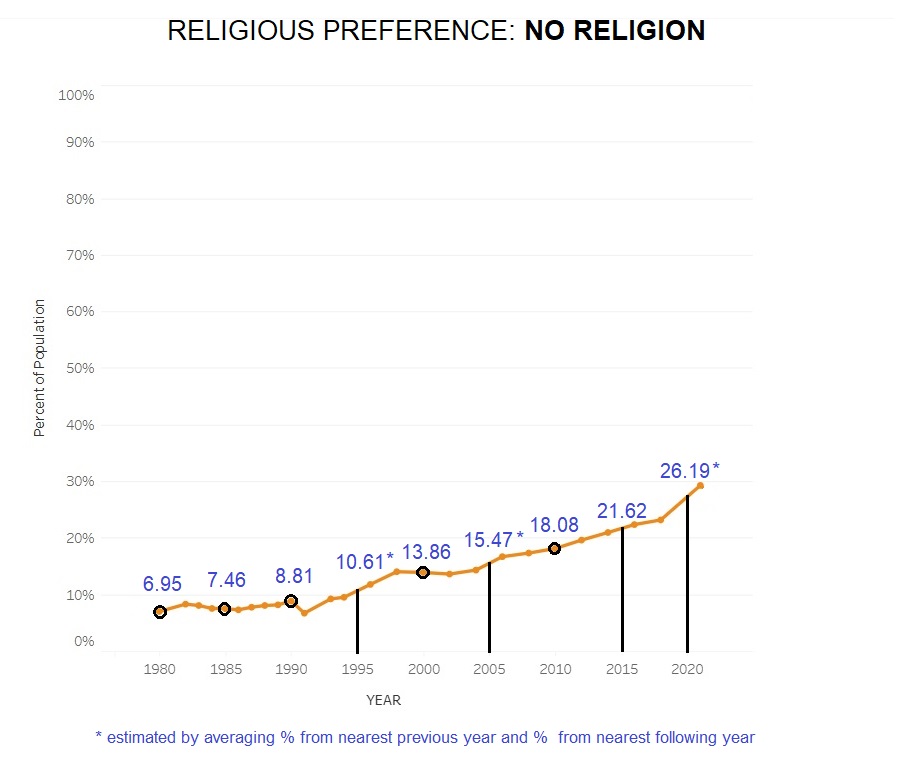
This graph is based on data gathered by the General Social Survey (GSS):
https://gssdataexplorer.norc.org/trends
“The General Social Survey (GSS) is a project of NORC at the University of Chicago, with principal funding from the National Science Foundation. Since 1972, the GSS has been monitoring societal change and studying the growing complexity of American society.”
Note that in the 20 years between 1980 and 2000, the percentage of the population that indicated that their religious preference is: “No Religion” doubled from about 7% in 1980 to about 14% in 2000. Similarly, in the 20 years between 2000 and 2020, the percentage of the population that indicated their religious preference is: “No Religion” nearly doubled from just under 14% in 2000 to a little over 26% in 2020. Clearly, religion has been on the decline in the USA for at least the past four decades.
Another indication that religion has been on the decline in the USA in recent decades is that the percentage of the population who never attend religious services has also been increasing over the past four decades:
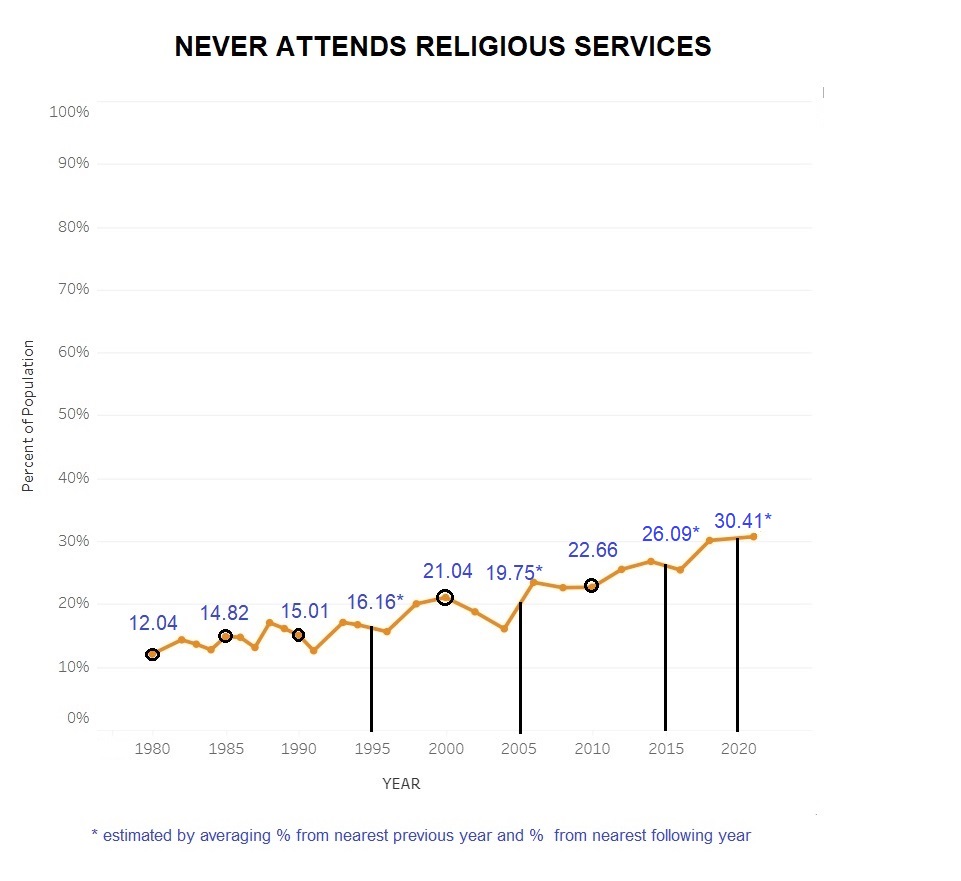
Note that in the 20 years between 1980 and 2000, the percentage of the population that indicated that they never attend religious services increased from about 12% in 1980 to about 21% in 2000. Similarly, in the 20 years between 2000 and 2020, the percentage of the population that indicated they never attend religious services increased from about 21% in 2000 to a little over 30% in 2020. Clearly, religion has been on the decline in the USA for at least the past four decades.
Because Christianity is the predominant religion in the USA, it should be no surprise, based on the clear decrease in religion in the USA in recent decades, that Christianity has also been decreasing in recent decades in the USA:
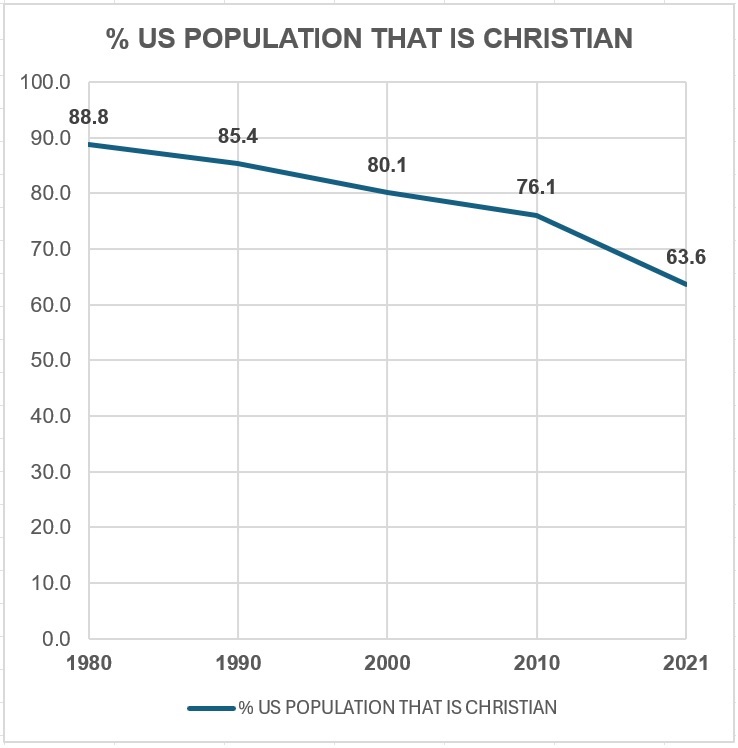
This graph is based on data gathered by the General Social Survey (GSS):
https://gssdataexplorer.norc.org/trends
The portion of the population that is Christian has decreased about 25% between 1980, when 88.8% of the population was Christian and 2021, when only 63.6% of the population was Christian.
Both religion in general, and Christianity in particular, has significantly decreased in the USA over the past four decades, and yet the divorce rate did not significantly increase. In fact, the opposite is the case. The divorce rate has significantly decreased along with the significant decrease in religion and Christianity. This is exactly the OPPOSITE of what one would expect if it were the case that religion or Christianity was a significant factor making religious people or Christians morally better people than non-religious people.
I am not claiming that the decrease in religion and in Christian belief CAUSED the decrease in the rate of divorce. I’m just saying that these facts cast serious doubt on the view that religion or Christianity makes people more morally good than non-religious people.
COMPARISON ACROSS SPACE: DIVORCE RATES IN STATES THAT ARE THE MOST RELIGIOUS TEND TO BE HIGHER THAN IN STATES THAT ARE THE LEAST RELIGIOUS
Based on recent survey data, I have ranked the states in the USA from the most religious to the least religious (see my recent post on this question: “Religiousness in TIME and SPACE“):
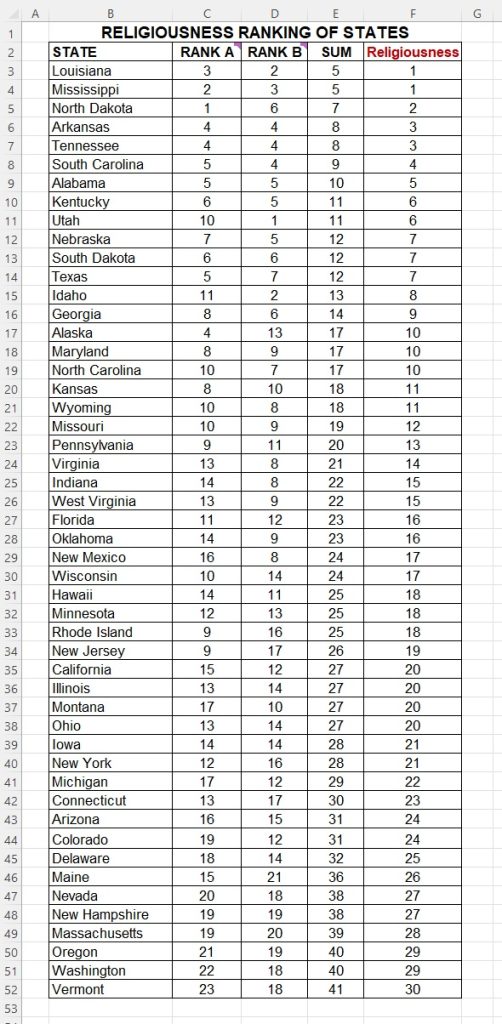
Because there are 30 different rankings of religiousness among the states, I have divided states into three levels of religiousness: the states in the Top Ten rankings are the most religious states; the states in the Bottom Ten rankings are the least religious states; and the states in the Middle Ten rankings are the moderately religious states. There are 17 states that fall into the Top Ten rankings (the most religious states); there are 19 states that fall into the Middle Ten rankings (the moderately religious states); there are 14 states that fall into the Bottom Ten rankings (the least religious states).
For divorce rates of the states, I again used data from The National Center for Marriage and Family Research at Bowling Green State University:
I rounded the percentages to one decimal place:
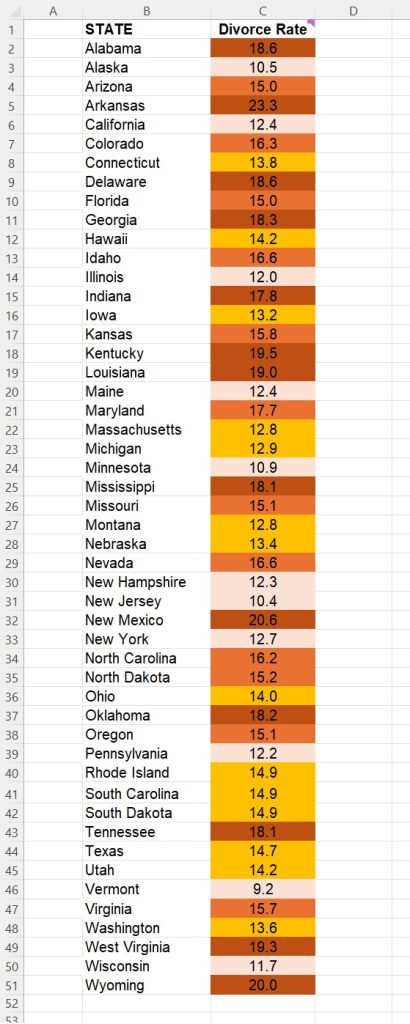
It turns out that the average divorce rate of the least religious states is significantly LOWER than the average divorce rate of the most religious states. Furthermore, the average divorce rate of the moderately religious states is IN BETWEEN the average divorce rate for the least religious states and the average divorce rate for the most religious states. This is the exact opposite of what we would expect if religion provided significant help for people to be morally good, to have good moral character.
Average Divorce Rate for the Most Religious States:
16.7
Average Divorce Rate for the Moderately Religious States:
14.9
Average Divorce Rate for the Least Religious States:
13.9
Furthermore, if we divide divorce rates into quartiles, following the analysis The National Center for Marriage and Family Research (reflected in the color coding in my table of divorce rates above), we see further confirmation of a positive correlation between religiosity and divorce:
Portion of the Most Religious States with Divorce Rates in the HIGHEST Quartile:
41.2%
Portion of the Moderately Religious States with Divorce Rates in the HIGHEST Quartile:
26.3%
Portion of the Least Religious States with Divorce Rates in the HIGHEST Quartile:
7.1%
Finally, if we look at the portion of each group of states that have divorce rates in the LOWEST Two Quartiles, we also see a positive correlation between religiosity and divorce:
Portion of the Most Religious States with Divorce Rates in the LOWEST Two Quartiles:
35.3%
Portion of the Moderately Religious States with Divorce Rates in the LOWEST Two Quartiles:
52.6%
Portion of the Least Religious States with Divorce Rates in the LOWEST Two Quartiles:
64.3%
Here is the state-by-state data supporting the above points:
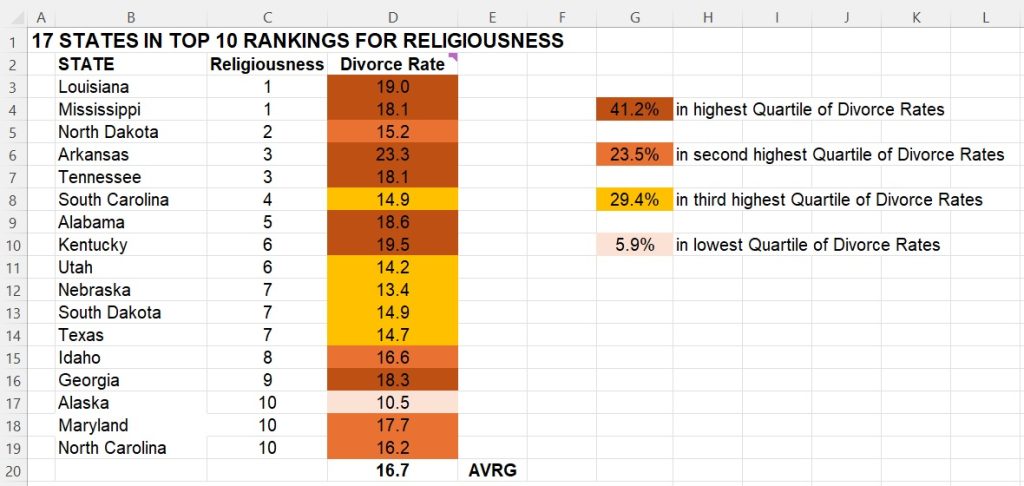
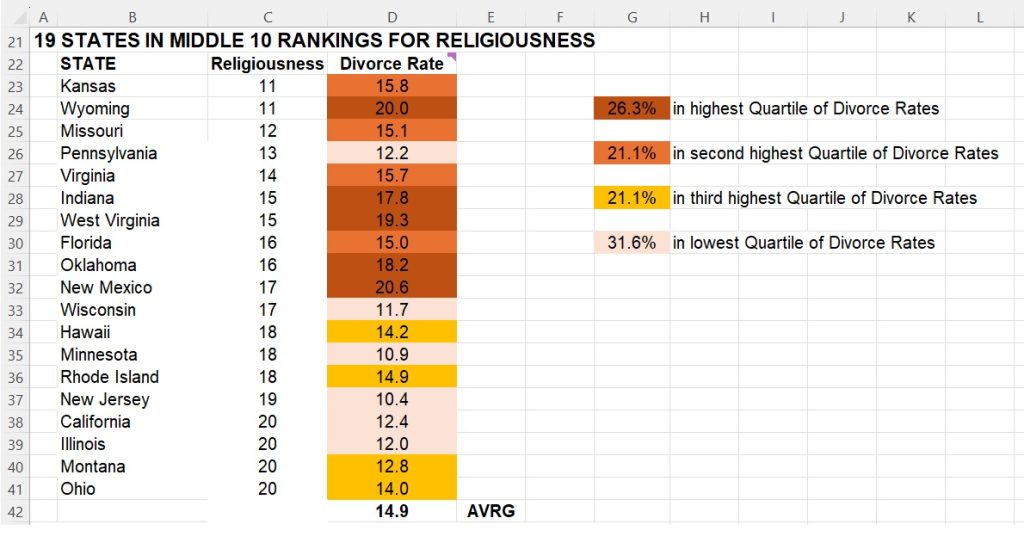
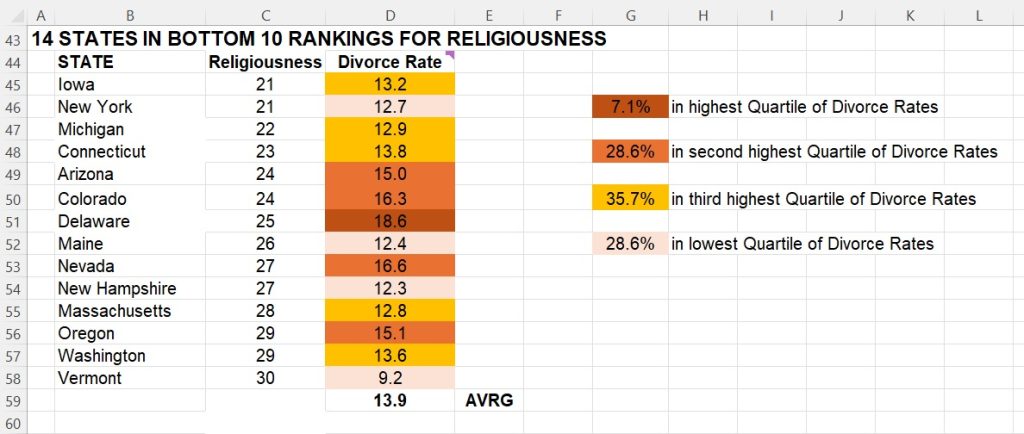
CONCLUSIONS
TIME:
Religion and Christianity have been declining in the USA since 1980. If religion or Christianity provided significant help for people to be morally good, to have good moral characters, then we would expect that the divorce rate in the USA would be increasing between 1980 and 2020, but the opposite is the case. The divorce rate has been declining between 1980 and 2020. This is evidence against the view that religion or Christianity help people to be morally good.
SPACE:
Some states are significantly more religious than other states. If religion or Christianity provided significant help for people to be morally good, to have good moral characters, then we would expect the divorce rate in states that are the most religious to be LOWER than the divorce rates in states that were the least religious. But the opposite is the case. The average divorce rate in the most religious states is significantly HIGHER than the average divorce rate in the least religious states, and the average divorce rate of moderately religious states fall in between the average divorce rate of the most religious states and the average divorce rate of the least religious states.
Furthermore, when we look at the portion of states with divorce rates in the HIGHEST Quartile, the group of the most religious states has the largest percentage of states with divorce rates in the HIGHEST Quartile, while the group of the least religious states has the smallest percentage of states with divorce rates in the HIGHEST Quartile, and the group of moderately religious states has a percentage of states with divorce rates in the HIGHEST Quartile that is in between the percentage of such states in the group of the most religious states and the percentage of such states in the group of the least religious states.
Finally, when we look at the portion of states with divorce rates in the LOWEST Two Quartiles, we find that the group of the most religious states has the smallest percentage of such states, while the group of the least religious states has the largest percentage of such states, and the group of moderately religious states has a percentage of such states that is in between the percentage of such states in the group of the most religious states and the percentage of such states in the group of the least religious states.
Not only does religiosity NOT correlate with decline in divorce, but the OPPOSITE appears to be the case, religiosity has a positive correlation with divorce. This is shown both by facts about religiosity and divorce over TIME (in different years and decades) and by facts about religiosity and divorce over SPACE (in different states in the USA).



